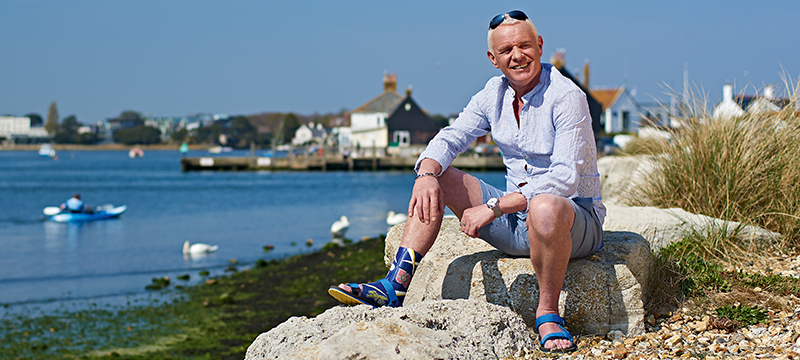UW, Hanger Institute Develop Orthosis Mobility Measurement Tool
Findings from a study conducted by the Hanger Institute for Clinical Research and Education and the University of Washington describe a new patient-reported outcome measure developed for people who use lower-limb orthoses.

The SAFO (silicone ankle foot orthosis) is a skin-friendly, custom-fabricated silicone orthosis. As a supplement to orthotic fittings, users with foot drop can wear the SAFO without a shoe at home, in wet areas and even when swimming. Otto Bock
by The O&P EDGE October 8, 2024
To create the Orthotic Patient-Reported Outcomes–Mobility (OPRO-M), study investigators administered candidate questions to more than 1,000 lower-limb orthosis users in a national survey. The data was used to calibrate select questions to a single measurement scale using a methodology called item response theory. The authors constructed 12- and 20-item shortened versions (short forms) of the instrument designed for use in clinical care and research.
“Despite the clinically recognized benefits of lower-limb orthoses, there is limited scientific evidence available to demonstrate their real-world effectiveness,” said Geoff Balkman, PhD, CPO, assistant professor of rehabilitation medicine at the University of Washington and first author of the study. “Self-report measures like OPRO-M can help clinicians and researchers more effectively assess those outcomes that matter most to patients.”
The OPRO-M was able to detect differences between participants grouped by type of paresis, number of comorbidities, type of orthosis, fall history, and assistive device use. Study investigators also found strong positive correlations between OPRO-M and previously validated surveys designed for other patient populations. Collectively, the findings indicated that OPRO-M can effectively measure the mobility of lower-limb orthosis users and help clinicians identify where possible improvements can be made.
The OPRO-M short forms and user guide can be found at opro-m.org.
More information about the study can be found on the Hanger Institute’s website.
Source The O&P EDGE
| References |
Correction: Development and initial validation of the Orthotic Patient-Reported Outcomes-Mobility (OPRO-M): An item bank for evaluating mobility of people who use lower-limb orthoses, Balkman GS, Bamer AM, Stevens PM, Weber EL, Morgan SJ, Salem R, Amtmann D, Hafne BJ. PLoS One. 2024 Aug 2;19(8):e0308468. doi: 10.1371/journal.pone.0308468. Erratum for: PLoS One. 2023 Nov 2;18(11):e0293848. doi: 10.1371/journal.pone.0293848. PDF
Development and initial validation of the Orthotic Patient-Reported Outcomes-Mobility (OPRO-M): An item bank for evaluating mobility of people who use lower-limb orthoses, Balkman GS, Bamer AM, Stevens PM, Weber EL, Morgan SJ, Salem R, Amtmann D, Hafner BJ. PLoS One. 2023 Nov 2;18(11):e0293848. doi: 10.1371/journal.pone.0293848. Erratum in: PLoS One. 2024 Aug 2;19(8):e0308468. doi: 10.1371/journal.pone.0308468. PDF
| Further reading |
Utilization of orthoses and assistive devices among a national sample of lower limb orthosis users, Stevens PM, Hafner BJ, Weber EL, Morgan SJ, Bamer AM, Salem R, Balkman GS. J Rehabil Assist Technol Eng. 2024 Jul 29;11:20556683241260891. doi: 10.1177/20556683241260891. Full text, PDF
Mobility experiences of adult lower limb orthosis users: a focus group study, Balkman GS, Hafner BJ, Rosen RE, Morgan SJ. Disabil Rehabil. 2022 Dec;44(25):7904-7915. doi: 10.1080/09638288.2021.2002437. Epub 2021 Nov 22. Full text, PDF
